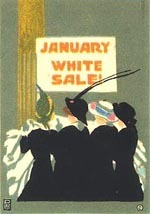My Books, etc.
The World of Department Stores
Service and Style: How the American Department Store Fashioned the Middle Class

Once, downtown department stores were the heart and soul of America’s pulsing Broadways and Main Streets. With names such as City of Paris, Penn Traffic, The Maze, Maison Blanche, or The Popular, they suggested spheres far beyond mundane shopping. Nicknames reflected the affection customers felt for their favorites, whether Woodie’s, Wanny’s, Stek’s, O.T.’s, Herp’s, or Bam’s.
The history of downtown department stores is as fascinating as their names and as diverse as their merchandise. Their stories encompass many themes: the rise of decorative design, new career paths for women, the growth of consumerism, and the technological ingenuity of escalators and pneumatic tubes. Just as the big stores made up their own small universes, their stories are microcosmic narratives of American culture and society.
For more about this book, click here.
Tea at the Blue Lantern Inn: A Social History of the Tea Room Craze in America
For more about this book, click here.
"Quick Lunch"
For more about this article and about quick lunch places, click here.
"Domesticating the Restaurant"
For more about this article and about women and restaurants, click here.